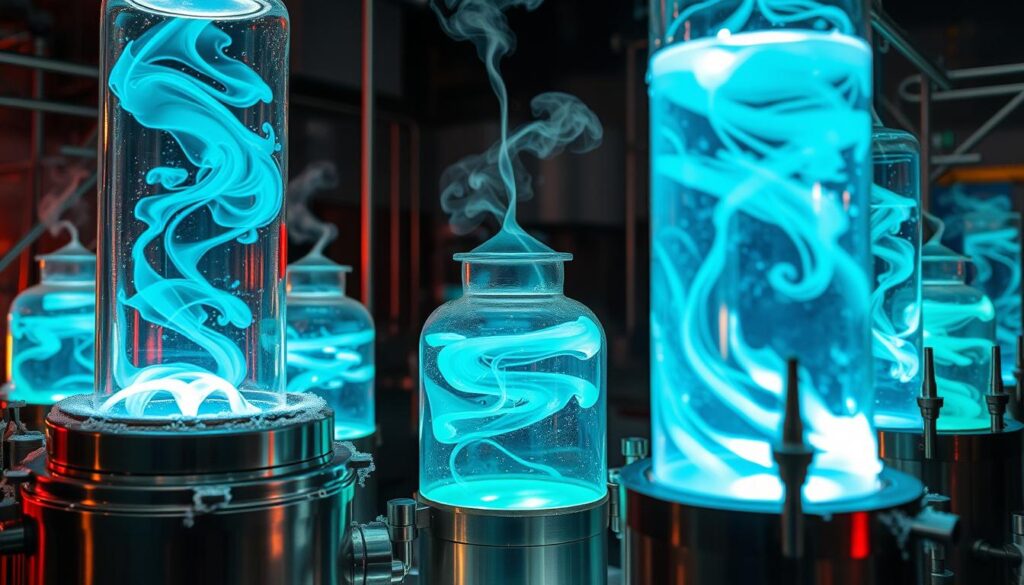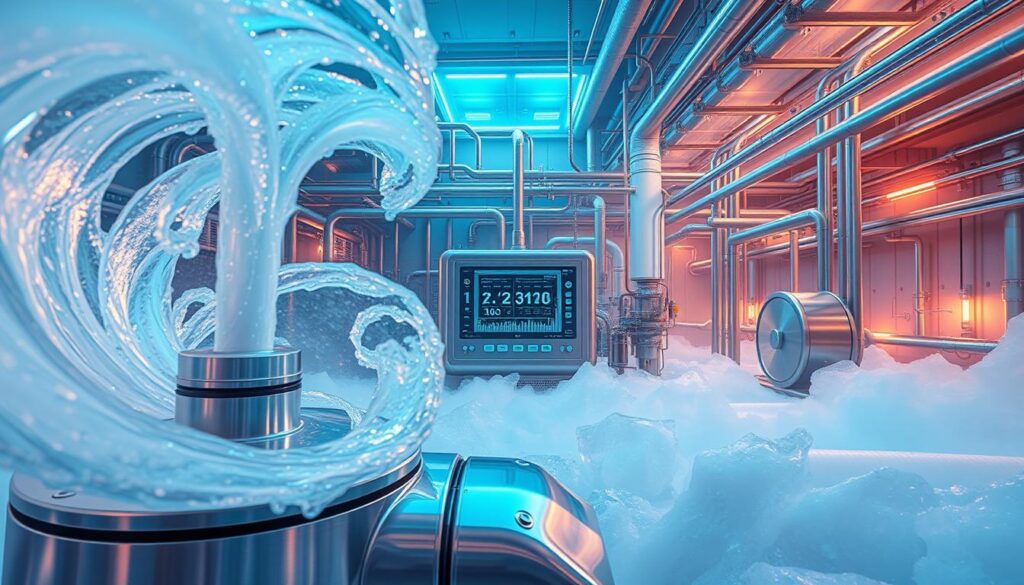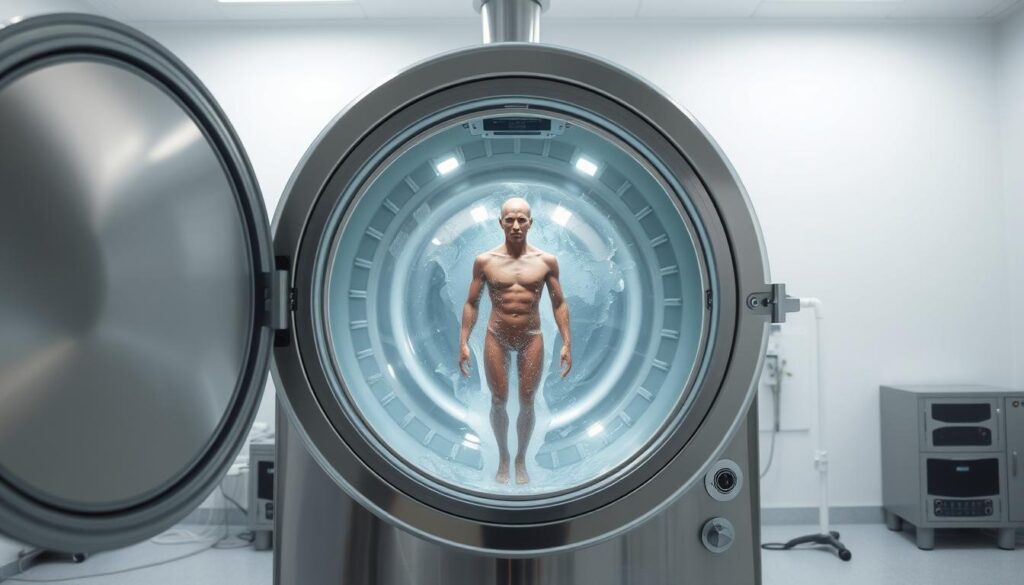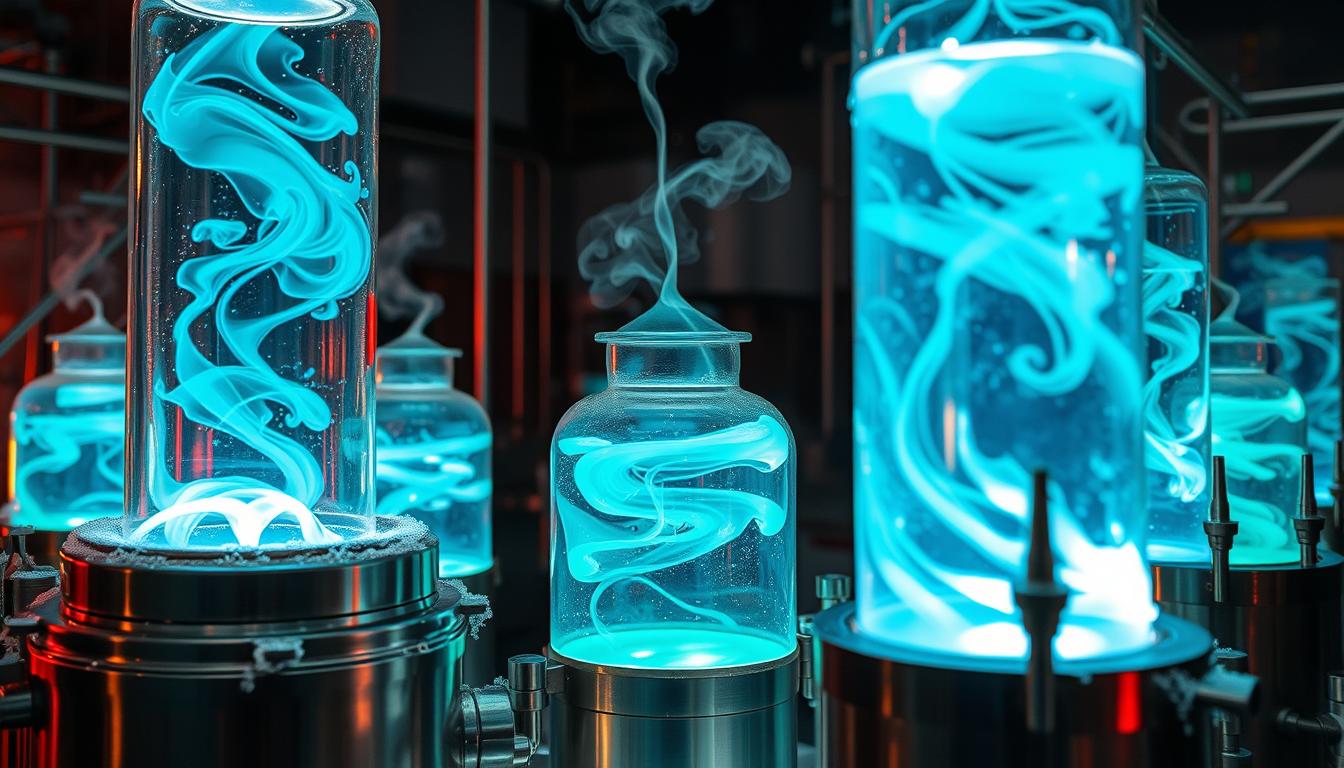Imagine a world where liquids never freeze, no matter the temperature. This idea might sound like science fiction, but it’s real in the world of cryogenic fluids. These fluids stay liquid even at very low temperatures, a process called supercooling. Scientists and researchers have been studying this for years, finding many uses for it.
Supercooling is a complex process in physics and chemistry. It involves changing how molecules are arranged. By understanding this, scientists can make liquids that never freeze. This could lead to new discoveries in medicine, energy, and transportation.

Liquids that never freeze are not just interesting; they also have big implications for many industries. They could help make better cooling systems and new materials. As scientists learn more about this, we’ll see new technologies and solutions.
Key Takeaways
- Liquids can remain in a liquid state at extremely low temperatures through a process called supercooling
- Cryogenic fluids have unique properties that make them ideal for various applications
- Supercooling involves the manipulation of molecular structures
- The study of cryogenic fluids and supercooling is a rapidly evolving field
- Potential applications of cryogenic fluids and supercooling include medicine, energy, and transportation
- Researchers are making new discoveries and breakthroughs in the field of cryogenic fluids and supercooling
Understanding the Phenomenon of Non-Freezing Liquids
Liquids usually freeze when it gets cold. But some liquids don’t freeze, which is important in low-temperature chemistry. Let’s explore why this happens.
The freezing point is when a liquid turns into a solid. This happens when its molecules slow down and form crystals. But some liquids can’t freeze, thanks to antifreeze solutions. These solutions keep liquids from freezing, even in very cold temperatures.
What makes a liquid not freeze? Its molecular structure, any impurities, and pressure are key. For instance, some liquids can’t form crystals because of their structure. Others have impurities that stop them from freezing. Scientists use this knowledge to create new antifreeze solutions for many uses, from low-temperature chemistry to industrial processes.
Non-freezing liquids have many uses:
- Cryopreservation of biological samples
- Low-temperature chemical reactions
- Industrial processes, such as refrigeration and air conditioning
Studying non-freezing liquids leads to new technologies. This field, including antifreeze solutions and low-temperature chemistry, is growing fast. It holds many exciting possibilities for medicine and industry.
The Science Behind a Liquid That Never Freezes
Scientists have long been intrigued by liquids that don’t freeze. Recent studies in cryogenic research have made these liquids even more fascinating. Cryogenic research focuses on materials at very low temperatures. It often uses coolants like liquid nitrogen or liquid helium.
Non-freezing substances can stay liquid even when it’s freezing outside. This happens through a process called supercooling. It’s when a liquid is cooled slowly to prevent ice crystals from forming. Examples include:
- Saltwater solutions, which can stay liquid below 0°C
- Certain alcohols, like ethanol and methanol
- Some organic compounds, like glycerol and ethylene glycol
Researchers keep exploring these substances for new uses. They could help in medicine, energy, and transportation. For instance, they might improve cooling systems or create new fuels.
Natural Examples of Freeze-Resistant Substances
Nature has found amazing ways to deal with cold temperatures. One cool example is the biological antifreeze in some living things. This lets them live in freezing places by making special proteins that stop ice from forming inside them.
In the Arctic and Antarctic, some fish and insects can handle the cold. They can make their body temperature go below freezing without freezing themselves. This lets them live in places where others would not survive.
- Antifreeze proteins in fish and insects
- Specialized compounds in Arctic plants that prevent ice formation
- Unique blood properties in Arctic wildlife that allow them to survive in extreme cold
These natural wonders have sparked interest in biological antifreeze and natural supercooling. This research could lead to big advances in medicine, farming, and materials science.
Synthetic Non-Freezing Solutions in Modern Technology
Synthetic non-freezing solutions have many industrial applications. They are used in medicine and aerospace. These solutions can handle very low temperatures, perfect for cryogenic technology.
In medicine, they help keep organs and tissues alive for transplants. In aerospace, they cool down electronic parts and fuel systems.
These solutions have changed many industries. For example, in cars, they make vehicles safer and more efficient. In energy, they cool down high-temperature systems, boosting efficiency.

Using synthetic non-freezing solutions brings many benefits. These include:
- Improved efficiency and safety
- Increased durability and lifespan of equipment
- Reduced maintenance and repair costs
These advantages make synthetic non-freezing solutions very appealing. Their use is likely to grow even more in the future.
Applications in Industrial Settings
Non-freezing solutions are key in many industrial settings. They help keep industrial cooling systems running smoothly. These systems keep temperatures just right, preventing damage to equipment. The science behind low-temperature engineering is vital for making these cooling systems work well.
In the car world, these solutions stop engine damage and keep cars running well. The space industry uses them to cool down electronic parts and avoid overheating. The energy sector also uses them to keep equipment cool and running efficiently.
- Stopping corrosion and damage to equipment
- Keeping temperatures right for best performance
- Helping make industrial cooling systems smaller and more efficient
By using non-freezing solutions, industries can work better, save money, and do more. As new research comes in, we’ll see even more cool uses of these solutions in the future.
Medical and Scientific Breakthroughs
Non-freezing solutions have many medical applications. They help preserve organs and tissues for transplants. Cryogenic preservation is a key area of research, aiming to change medicine.
Here are some main uses of non-freezing solutions:
- Organ transplantation: These solutions keep organs fresh for longer, boosting transplant success rates.
- Tissue engineering: They help preserve tissue samples for research, leading to new treatments.
- Cryogenic preservation: This method uses very low temperatures to save cells, tissues, and organs. The goal is to revive them later.
These advances in medical applications and cryogenic preservation could greatly improve health and life quality. As research grows, we’ll see more uses of non-freezing solutions in medicine.

Environmental Impact and Considerations
As we work on non-freezing solutions, we must think about their effect on the environment. It’s vital to focus on environmental sustainability because ignoring it can lead to big problems. These solutions can harm ecosystems, so we need to find eco-friendly solutions that are gentle on the planet.
When looking at the environmental impact of non-freezing solutions, we should consider a few things:
- Chemical composition and potential toxicity
- Biodegradability and potential for persistence in the environment
- Impact on aquatic and terrestrial ecosystems
By focusing on environmental sustainability and eco-friendly solutions, we can lessen harm to the environment. This can be done by using materials that break down easily, reducing waste, and making products in a sustainable way.
| Factor | Environmental Impact | Sustainability Considerations |
|---|---|---|
| Chemical Composition | Potential toxicity and persistence in the environment | Use of biodegradable and non-toxic materials |
| Biodegradability | Potential for accumulation in ecosystems | Design for biodegradability and recyclability |
| Aquatic and Terrestrial Ecosystems | Potential for disruption of ecosystems and loss of biodiversity | Implementation of sustainable manufacturing practices and waste minimization |
In the end, making and using non-freezing solutions must be done with care for the environment. By keeping environmental sustainability and eco-friendly solutions in mind, we can help the planet stay healthy and ensure a future that’s good for everyone.
Future Possibilities and Research Directions
Looking ahead, the future of non-freezing solutions is promising. Future research aims to make these solutions more efficient and green. This might involve emerging technologies like nanotechnology or advanced materials science.
Some areas to explore in future research include:
- Creating new materials that resist freezing better
- Boosting the performance of current non-freezing solutions
- Discovering new uses for these solutions, like in medicine or energy
The use of emerging technologies in non-freezing solutions could change many industries. For instance, advanced materials could lead to greener and more efficient solutions. As future research progresses, we’ll see new and creative ways to use non-freezing solutions.
Safety Considerations and Handling Protocols
Working with non-freezing solutions requires strict safety rules. These rules help keep you safe while using these substances. They cover how to store them, protect yourself, and what to do in emergencies.
It’s vital to follow safety protocols closely. Non-freezing solutions can be dangerous if not handled right. Proper training and the right tools are key. Always stick to the set procedures. Wear gloves and goggles, and make sure the area has good air flow.
Some important safety tips are:
- Keep non-freezing solutions in a cool, dry spot, away from sunlight and heat.
- Use gloves and goggles when working with these substances.
- Always follow the safety rules and procedures.
By following these safety tips and procedures, you can handle non-freezing solutions safely. This is important in many fields, like cars and planes, where these substances are used. Always put safety first when working with non-freezing solutions.
Conclusion: The Revolutionary Impact of Non-Freezing Liquids
Throughout this article, we’ve seen how non-freezing liquids are changing the game in many fields. They’re making a big difference in cars, space travel, medicine, and helping the environment. These liquids are opening up new possibilities and pushing what we thought was possible.
These liquids can stay liquid even when it’s freezing cold. This has led to many breakthroughs. They help us solve problems, make things safer, and drive new ideas. As scientists learn more about these liquids, we can expect even more amazing things.
The story of non-freezing liquids is about curiosity, progress, and solving big problems. By understanding these liquids, we can use their power to create a better, more innovative world. This will help us face challenges and make our future stronger and more sustainable.
FAQ
What is a liquid that never freezes?
A liquid that never freezes is a substance that stays liquid even in very cold temperatures. It doesn’t freeze like normal liquids do. This is because it has special chemical properties.
What are the basic principles behind non-freezing liquids?
The basic idea is to lower the freezing point by adding certain substances. This stops ice from forming. So, the liquid stays liquid even when it’s cold.
What are some common examples of non-freezing liquids?
Examples include cryogenic fluids like liquid nitrogen and liquid helium. Also, there are special antifreeze solutions used in cars, planes, and power plants.
How do non-freezing liquids find applications in modern technology?
They are used in many ways, like keeping things cold for storage and cooling systems. They also help in medicine and science. Their ability to stay liquid in cold temperatures is very useful.
What are the environmental considerations around the use of non-freezing liquids?
It’s important to think about how they affect the environment. We need to look at their ecological impact and energy use. We also want to find green alternatives. Research is ongoing to make them more eco-friendly.
What are the safety protocols for handling non-freezing liquids?
Handling them safely is crucial because they are very cold. You need the right storage and protective gear. Knowing what to do in emergencies is also key. Following safety rules helps keep everyone safe.
